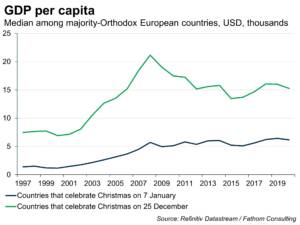A sideways look at economics
January is the New Jersey of months (apologies to any readers from the Garden State). After a heady December, many people face the New Year broke and cold (and hoping they have just a cold). During these dark days, I’ll forgive those who wish it could be Christmas every day. I’ll go further, and deliver some good news: it really is Christmas today — at least for many of the 260 million Orthodox Christians around the world. This is because most Orthodox countries still base their religious holidays on the Julian calendar. Most — but not all, however. Greece decided to switch to the Gregorian date in 1924 and now celebrates on 25 December, for example, while nearby Serbia has stuck to the old calendar. In Europe, when a majority-Orthodox nation opts to celebrate Christmas can be surprisingly revealing.
The vast majority of the world uses the Gregorian calendar, which was introduced by Pope Gregory XIII in 1582. It replaced the Julian calendar (introduced by Julius Caesar), which had an admirably long run, but was eleven minutes out of sync with the earth’s rotation, leading to a ‘misalignment between the astronomical and calendar years’ that eventually threatened to bump Easter beyond its traditional spring equinox.[1] The Gregorian calendar was introduced in part to fix this, cutting ten days, and shortening the misalignment to just 26 seconds.
Its impact on the world was not due to its astrological merit (indeed, a couple of US economists propose an improved calendar made up of 91-day quarters where every date would fall on the same day every year) but rather what its international adoption symbolised. Previously, different places had their own calendars based on local climate and custom (e.g., when the river Nile would rise). They weren’t comparable. The pope’s introduction marked the beginning of a new era of proto-globalisation, amid increasing international trade, with Western Europe as the primary hub. The Industrial Revolution and the Age of Imperialism would follow.
Several centuries on, almost all of the world’s countries follow the Gregorian calendar. However, this transition hasn’t always been replicated for religious observations. Among majority-Orthodox European countries, Cyprus, Bulgaria, Greece and Romania have switched to celebrate on 25 December, matching Western Europe. Meanwhile, Belarus, Georgia, Moldova, Montenegro, North Macedonia, Serbia, Russia and Ukraine maintain the Julian date of 7 January. It seems the 25 December foursome knew what they were doing when they switched: they enjoy a GDP per capita that is more than double that of European countries that continue to celebrate on 7 January.

Which day a country chooses to observe a national holiday is pretty much irrelevant from an economic perspective. In this case, however, the differences are symbolic of a country’s priorities. All four that switched to 25 December are also in the EU, with Cyprus the sole absentee from NATO. None of the others is in the EU, and only Montenegro is in NATO. Similar differences can be seen in measures of corruption and democracy. The adoption of 25 December points to a general preference for a Western European institutional profile over a Soviet/Russian one. Western Europe has a better track record of delivering economic growth and that choice has paid off handsomely. However, the gap between these two blocs has narrowed over the past decade or so, following large recessions in Cyprus and Greece during the European debt crisis. Calendars, like superpowers, aren’t permanent. Neither, it seems, are relative incomes.
Счастливого Рождества if you celebrate, and Thank Fathom it’s Friday to all!